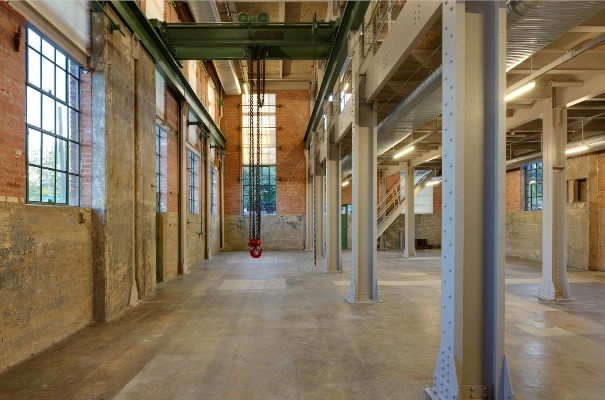A Dallas art collector is making a name for himself in the world of contemporary art. And while you can’t see his collection in the art gallery he runs, you can see it at the Dallas Museum of Art. KERA’s Stephen Becker has the story:
- KERA Radio story:
Audio Player
- Online version:
Most art galleries and museums feature plain, white walls and harsh fluorescent lighting. The Power Station near Deep Ellum is flooded with sunlight from three stories of windows between walls made of brick and mortar.
Oh, and it has a working crane in the middle of the showroom floor.
The Power Station began life as a Dallas Power and Light station in the 1920s. But Dallas art collector Alden Pinnell has converted it into a place to showcase ambitious contemporary art. It opened last year and is currently home to an installation by Virginia Overton. Her work is usually shown in elite New York galleries, but for the Power Station, Overton wanted her exhibition to include an old pickup truck with a bed that lights up. Pinnel said, OK.
That freedom has artists eager to explore the space.
“They understand there’s gonna be quirky challenges, different kinds of dimensions,” Pinnell says during an interview at The Power Station. “There’s going to be windows were normally walls would be, there’s gonna be steel beams, and I think it really turns them on – they get really excited about it.”
The Power Station has also turned on local contemporary art fans.
“Those in the know know where it is, show up, look at the art, are confused by it or satisfied with it – we’re happy to be there,” says Joan Davidow, a former head of the Dallas Contemporary who now teaches Contemporary art survey courses in SMU’s Masters of Liberal Arts program.
Pinnell has been collecting art most of his life. His mother, a photographer, used to give him photographs for his birthday as a kid growing up in Durham. N.C. After attending SMU, he co-founded a skincare company that he sold in 2005. That allowed him to pursue collecting fulltime. He and his wife, Janelle, spend several weeks a year visiting major art fairs around the world.
“If you’re buying clothing, you’re essentially buying something that many, many other people are buying,” he says. “It’s not a truly unique thing. Collecting contemporary art I think – putting together a collection – says a lot about someone – their tastes, their interests. And that’s exhilarating.”
So what does Pinnell’s collection say about him?
“What I see says a lot about the artists that he’s bringing in and about Pinnell as a collector,” Davidow says. “Which is – he’s adventurous, he’s young, he wants to pick up on the European concept of this rawness and he’s inviting artists and giving them great freedom to experience his space artistically.”
Pinnell keeps his private collection separate from The Power Station. However, you can see some of it at the Dallas Museum of Art. Pinnell has been collecting Mark Manders’ sculptures for about eight years. The Dutch artist is currently the focus of a solo exhibition at the DMA that includes three works owned by Pinnell.
“It’s another great example of great collectors in this community acquiring works that are really important and will have an important place in the community,” says Jeffrey Grove, the museum’s senior curator of contemporary art.
The Manders exhibit is challenging. Included are partially-formed figures, scale-replicas of common items like chairs and fake newspapers. One piece features a cat figure sawed in half. While some viewers will connect with the craftsmanship and attention to detail, others will leave baffled.
Pinnell admits he doesn’t exactly grasp it all.
“I don’t feel a need to truly understand – and I don’t think with Mark’s work anyone is going to ever understand exactly what’s going on – I don’t think even the best scholars and curators of his work purport to know exactly what’s going on. And that mystery I think is part of what’s fascinating.”







0 Comments